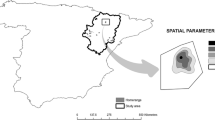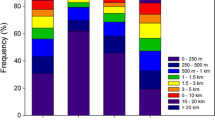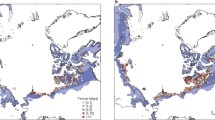Abstract
There is very little confirmed information on the social organisation of breeding Lesser Spotted Eagle populations, the turnover rate of adults, and their nest-site and partner fidelity. According to established knowledge, however, breeding individuals are territorial and defend at least the immediate vicinity of the nest site against their own species. It has further been thought that females rearing young, as with the females of other raptor species, remain within a radius of only a few kilometres of their eyrie. Using GPS satellite telemetry and DNA microsatellite analysis (DNA STR typing), we were able to disprove this prevailing hypothesis. A satellite-tracked female flew over 50 km away from her eyrie (D) in at least two different directions and visited at least one other occupied eyrie (T). It was also established that at least two strange females arrived at her eyrie, which contained young, from as far away as 57 km, and probably remained there for some considerable time. The pool of alleles represented at the different loci analysed, as well as the distribution of these alleles among the individuals, excludes the possibility that these females could be sisters or even half-sisters. Visits of strange eagles at this eyrie were also confirmed by direct observation. It can therefore be assumed that males only exhibit territorial behaviour towards their own sex and not towards strange females and that females do not exhibit territorial behaviour towards other females; but all these assumptions must be confirmed by further studies. For the first time it could be proved by means of microsatellite analysis that almost all females studied used the same breeding site for 2 consecutive years. The longest established period in which both partners of a pair remained at the same breeding site was 3 consecutive years.


Similar content being viewed by others
References
Argos (1996) User’s manual. CLS/Service Argos, Toulouse
Bloom PH (1987) Capturing and handling raptors. In: Pendleton BAG, Millsap BA, Cline KW, Bird DM (eds) Raptor management techniques manual. National Wildlife Federation, Washington, pp 99–123
Clark WS (1981) A modified dho-gaza trap for use at a raptor banding station. J Wildl Manage 45:1043–1044
Danko S, Meyburg B-U, Belka T, Karaska D (1996) Individuelle Kennzeichnung von Schreiadlern Aquila pomarina: Methoden, bisherige Erfahrungen und Ergebnisse. In: Meyburg B-U, Chancellor RD (eds) Eagle studies. WWG on Birds of Prey, Berlin, pp 209–243
Dobay L von (1934) Beiträge zur Biologie der Schrei- und Schelladler. Kócsag 7:31–39
Fancy SG, Pank LF, Douglas DC, Curby CH, Garner GW, Amstrup SC, Regelin WL (1988) Satellite telemetry, a new tool for wildlife research and management. U.S. Fish and Wildlife Service Resour. Publ. No. 172. U.S. Fish and Wildlife Service, Fairbanks, 172 pp
Forero MG, Donazar JA, Blas J, Hiraldo F (1999) Causes and consequences of territory change and breeding dispersal distance in the Black Kite. Ecology 80:1298–1310
Gedeon K, Stubbe M (1991) Tagesrhythmik, Raumnutzung und Jagdverhalten des Schreiadler Aquila pomarina Brehm. Populationsökolog Greifvogel- u. Eulenarten 2:107–129
Griffiths R, Double MC, Orr K, Dawson RJG (1998) A DNA test to sex most birds. Mol Ecol 7:1071–1075
Hamerstrom F (1963) The use of Great Horned Owls in catching Marsh Hawks. Proc Int Ornithol Congr 13:866–869
Jenkins MJ, Jackman RE (1993) Mate and nest site fidelity in a resident population of Bald Eagles. Condor 95:1053–1056
Martinez-Cruz M, David VA, Godoy JA, Negro JJ, O’Brien SF, Johnson WE (2002) Eighteen polymorphic microsatellite markers for the highly endangered Spanish imperial eagle (Aquila adalberti) and related species. Mol Ecol Notes 2:323–326
McDonald PG, Olsen PD, Baker-Gabb DJ (2003) Territory fidelity, reproductive success and prey choice in the Brown Falcon, Falco berigora: a flexible bet-hedger? Aust J Zool 51:399–414
Meyburg B-U (1970) Zur Biologie des Schreiadlers (Aquila pomarina). Jb Dt Falkenorden 1969:32–66
Meyburg B-U (1991) Der Schreiadler (Aquila pomarina): Bisherige und zukünftige Bemühungen um seine Erforschung und seinen Schutz. Populationsökologie Greifvogel u. Eulenarten 2:89–105
Meyburg B-U (2005) Zug und Verfolgung der Greifvögel in der südlichen Türkei. Orn Mitt 57:12–16
Meyburg B-U, Scheller W, Meyburg C (1995) Zug und Überwinterung des Schreiadlers Aquila pomarina: Satellitentelemetrische Untersuchungen. J Ornithol 136:401–422
Meyburg B-U, Meyburg C, Belka T, Sreibr O, Vrana J (2004) Migration, wintering and breeding of a Lesser Spotted Eagle (Aquila pomarina) from Slovakia tracked by Satellite. J Ornithol 145:1–7
Meyburg B-U, Belka T, Danko Š, Wójciak J, Heise G, Blohm T, Matthes H (2005) Geschlechtsreife, Ansiedlungsentfernung, Alter und Todesursachen beim Schreiadler (Aquila pomarina). Limicola 19:153–179
Meyburg B-U, Meyburg C, Matthes J, Matthes H (2006) GPS-Satelliten-Telemetrie beim Schreiadler (Aquila pomarina): Aktionsraum und Territorialverhalten. Vogelwelt 127:127–144
Newton I (1979) Population ecology of raptors. Berkhamsted, Poyser
Newton I (1986) The Sparrowhawk. Calton, Poyser
Rudnick JA, Katzner TE, Bragin EA, Rhodes OE, Dewoody JA (2005) Using naturally shed feathers for individual identification, genetic parentage analyses, and population monitoring in an endangered Eastern Imperial Eagle (Aquila herliaca) population from Kazakhstan. Mol Ecol 14:2959–2967
Scheller W, Bergmanis U, Meyburg B-U, Furkert B, Knack A, Röper S (2001) Raum-Zeit-Verhalten des Schreiadlers (Aquila pomarina). Acta Ornithoecologica 4:75–236
Wendland V (1932) Zur Biologie des Schreiadlers (Aquila pomarina). Beitr. Fortpflanzungsbiol. Vögel 8(1–9):47–53
Wendland V (1951) Zwanzigjährige Beobachtungen über den Schreiadler Aquila pomarina. Vogelwelt 72:4–11
Wink M, Staudter H, Bragin Y, Pfeffer R, Kenward R (1999) The use of DNA fingerprinting to estimate annual survival rates in the Saker falcon (Falco cherrug). J Ornithol 140:481–489
Ziesemer F (1983)Untersuchungen zum Einfluß des Habichts (Accipiter gentilis) auf Populationen seiner Beutetiere. Beitr Wildbiol 2:1–127
Ziesemer F (1999)Habicht (Accipiter gentilis) und Wespenbussard (Pernis apivorus)—zwei Jäger im Verborgenen: was hat die Telemetrie Neues gebracht? Egretta 42:40–56
Acknowledgements
Our thanks go to Dr. Torsten Langgemach of the Staatlichen Vogelschutzwarte des Landesumweltamtes Brandenburg and to Dr. Lothar Wölfel (Landesamt für Umwelt, Naturschutz und Geologie Mecklenburg-Vorpommern) for permission to catch the eagles and fit them with transmitters. As in previous years, the Rostock Zoo (Director Dipl. Agr. Udo Nagel) provided us with an adult White-tailed Eagle as decoy. Joachim Matthes, Hinrich Matthes, Prof. Kai Graszynski, Torsten Blohm and Dr. Günter Heise assisted us in the trapping of the eagles. Paul Sömmer checked many eyries and collected material used here while Carsten Rohde also supported our study in a number of ways. Andreas Hofmann and the Hiddensee Ringing Station (Dr. Ulrich Koeppen) provided us with information on the ringing of one female as a nestling. We thank Ulf Kraatz for his detailed observations from breeding site R and Martin Neubauer from nest site C. Moult feathers for the DNA analysis were provided by Dr. Torsten Langgemach, Prof. Kai Graszynski, Torsten Blohm, Dr. Peter Wernicke and several other ornithologists. We further thank Prof. Ian Newton, Dr. Ülo Väli, Prof. Jörg Böhner, R. D. Chancellor and two unknown referees for helpful comments on the first draft of the manuscript. All research performed on Lesser Spotted Eagles fully complies with both the regional and German law on protected species and protected areas.
Author information
Authors and Affiliations
Corresponding author
Additional information
Communicated by M. Wink.
Rights and permissions
About this article
Cite this article
Meyburg, BU., Meyburg, C. & Franck-Neumann, F. Why do female Lesser Spotted Eagles (Aquila pomarina) visit strange nests remote from their own?. J Ornithol 148, 157–166 (2007). https://doi.org/10.1007/s10336-006-0113-1
Received:
Revised:
Accepted:
Published:
Issue Date:
DOI: https://doi.org/10.1007/s10336-006-0113-1




